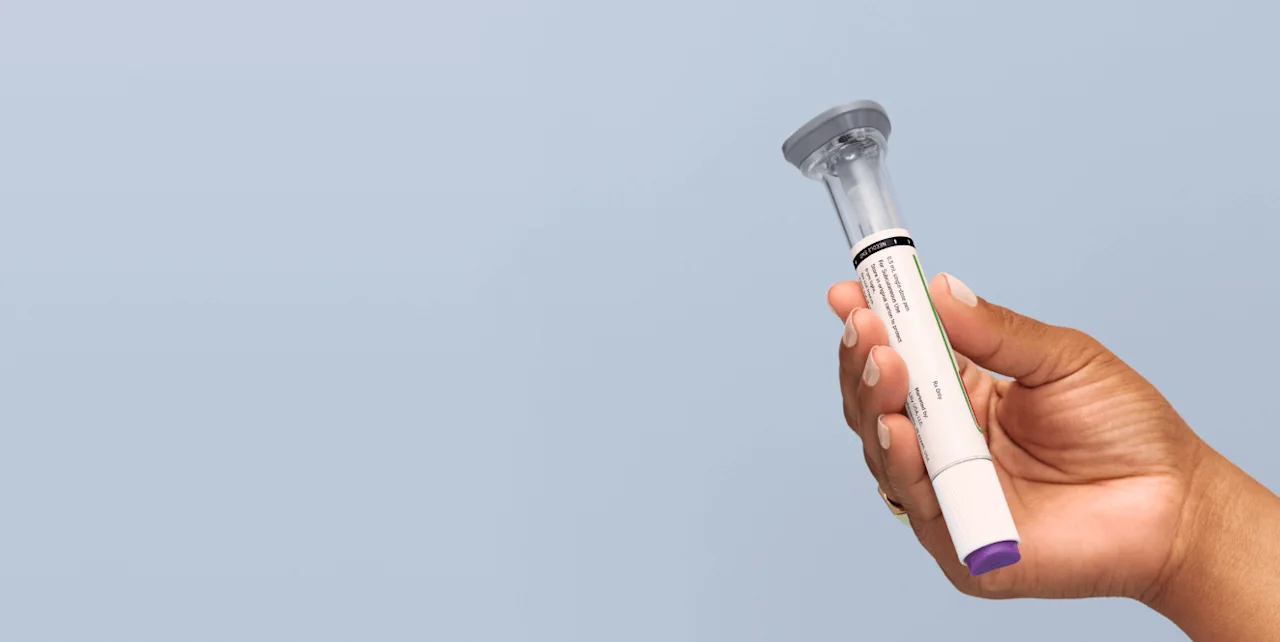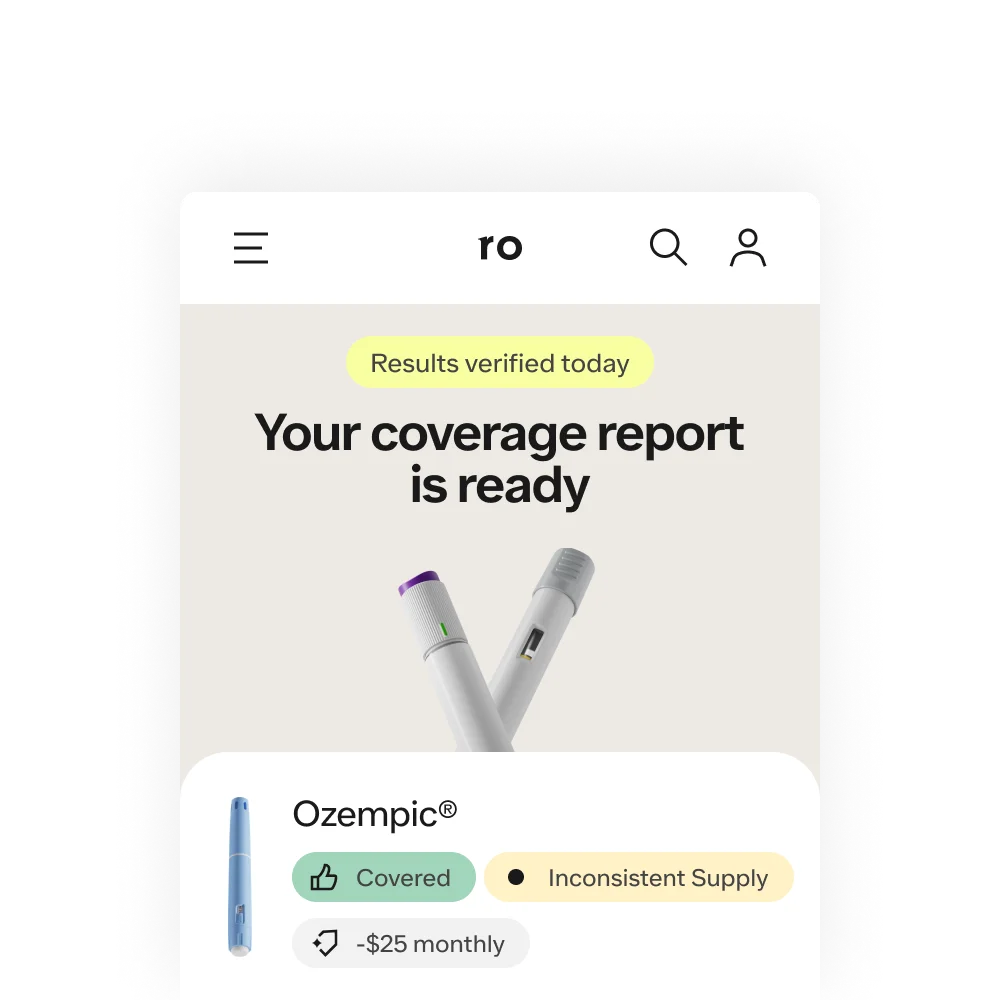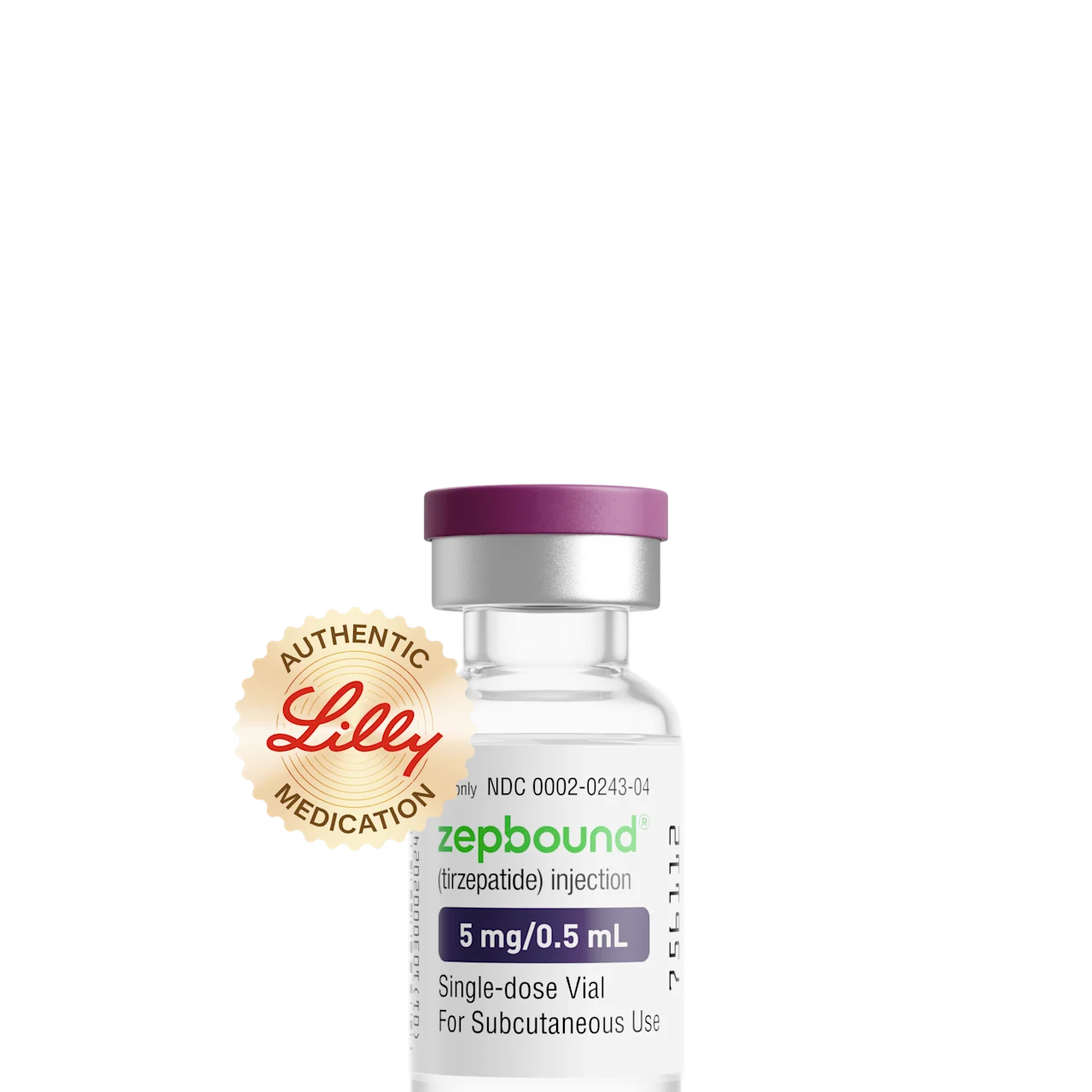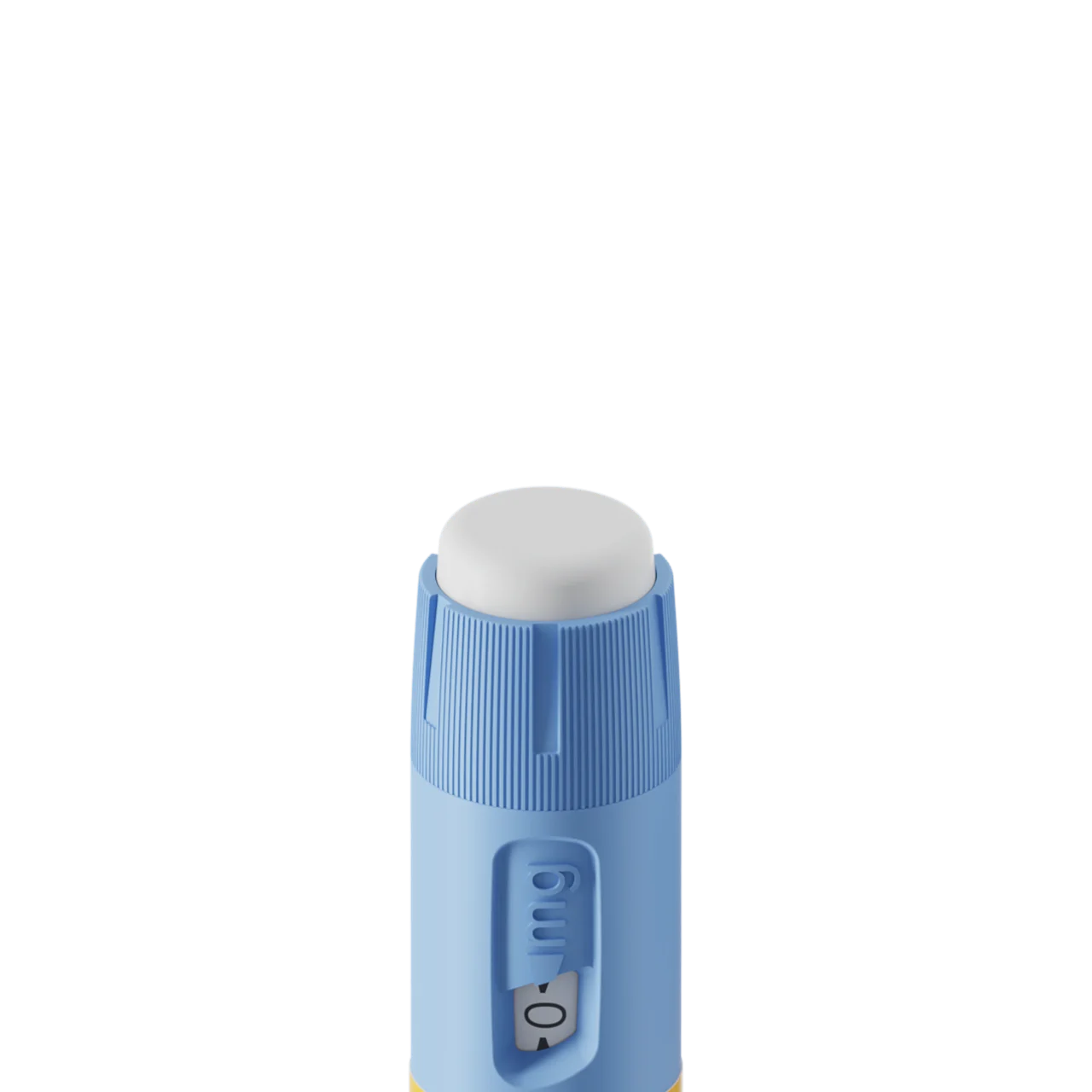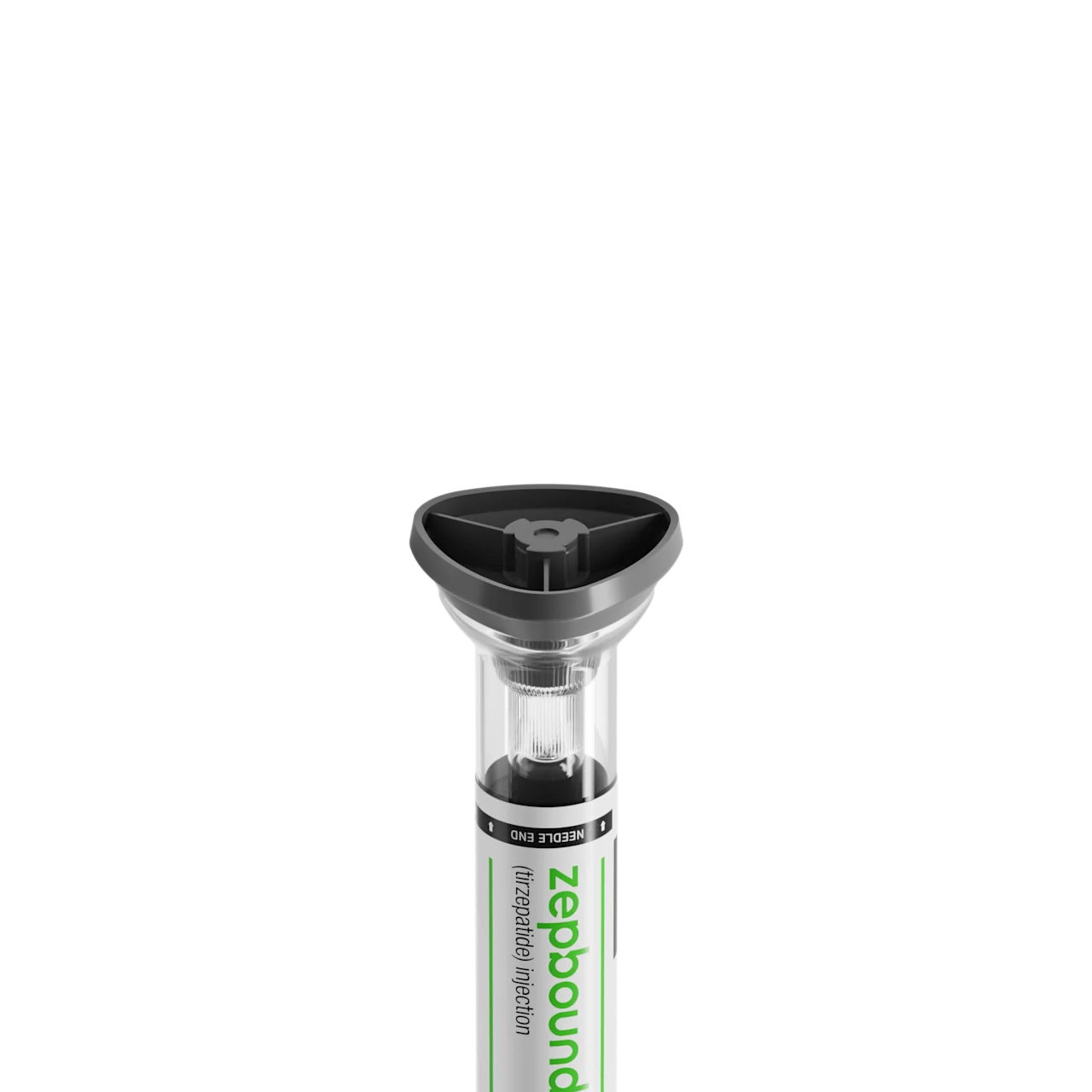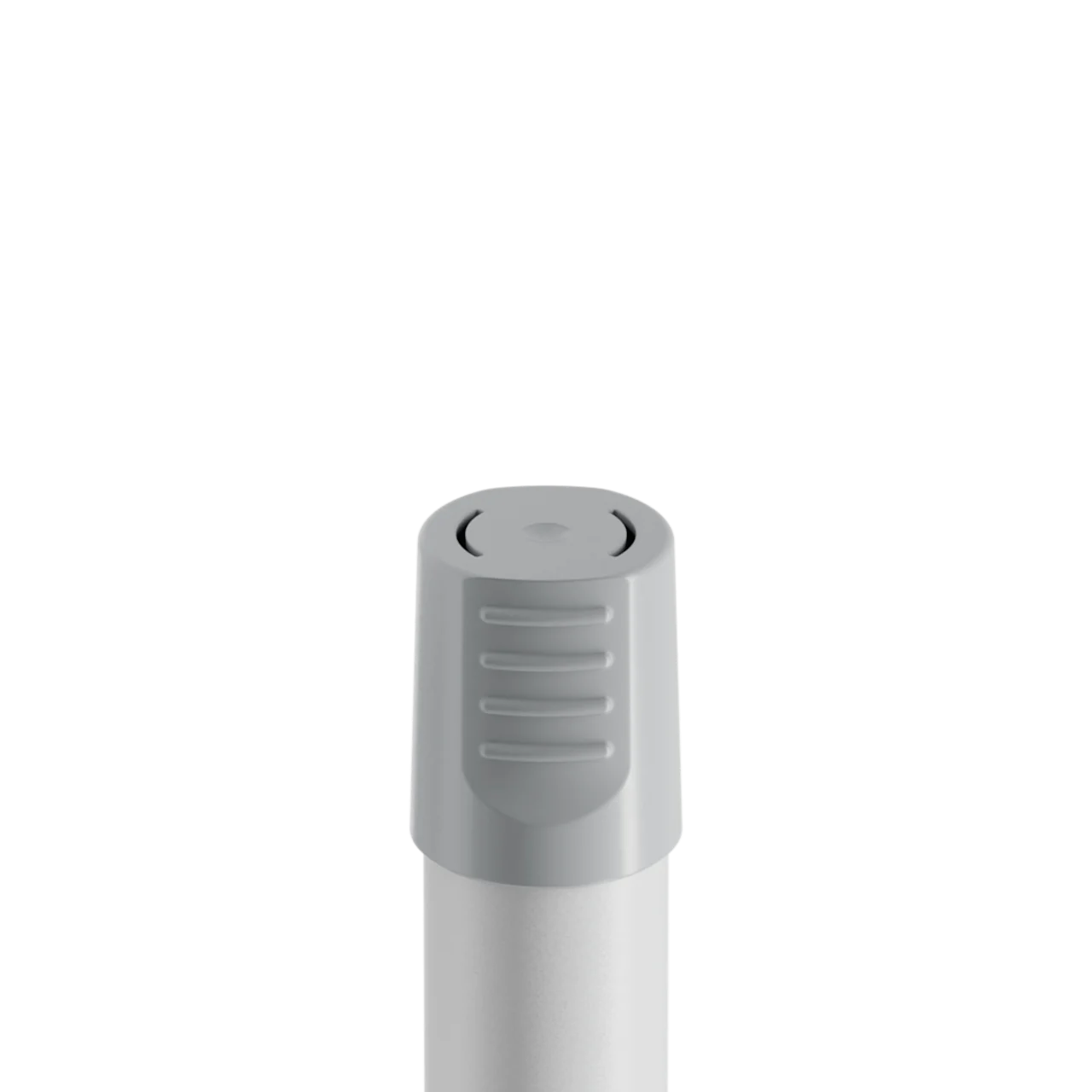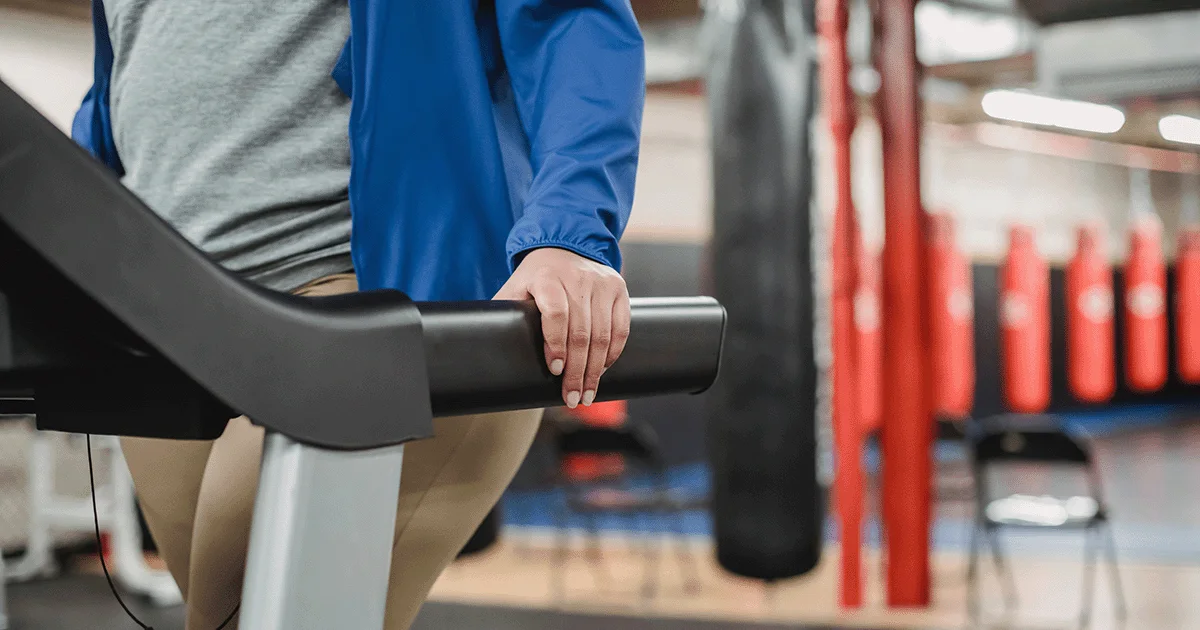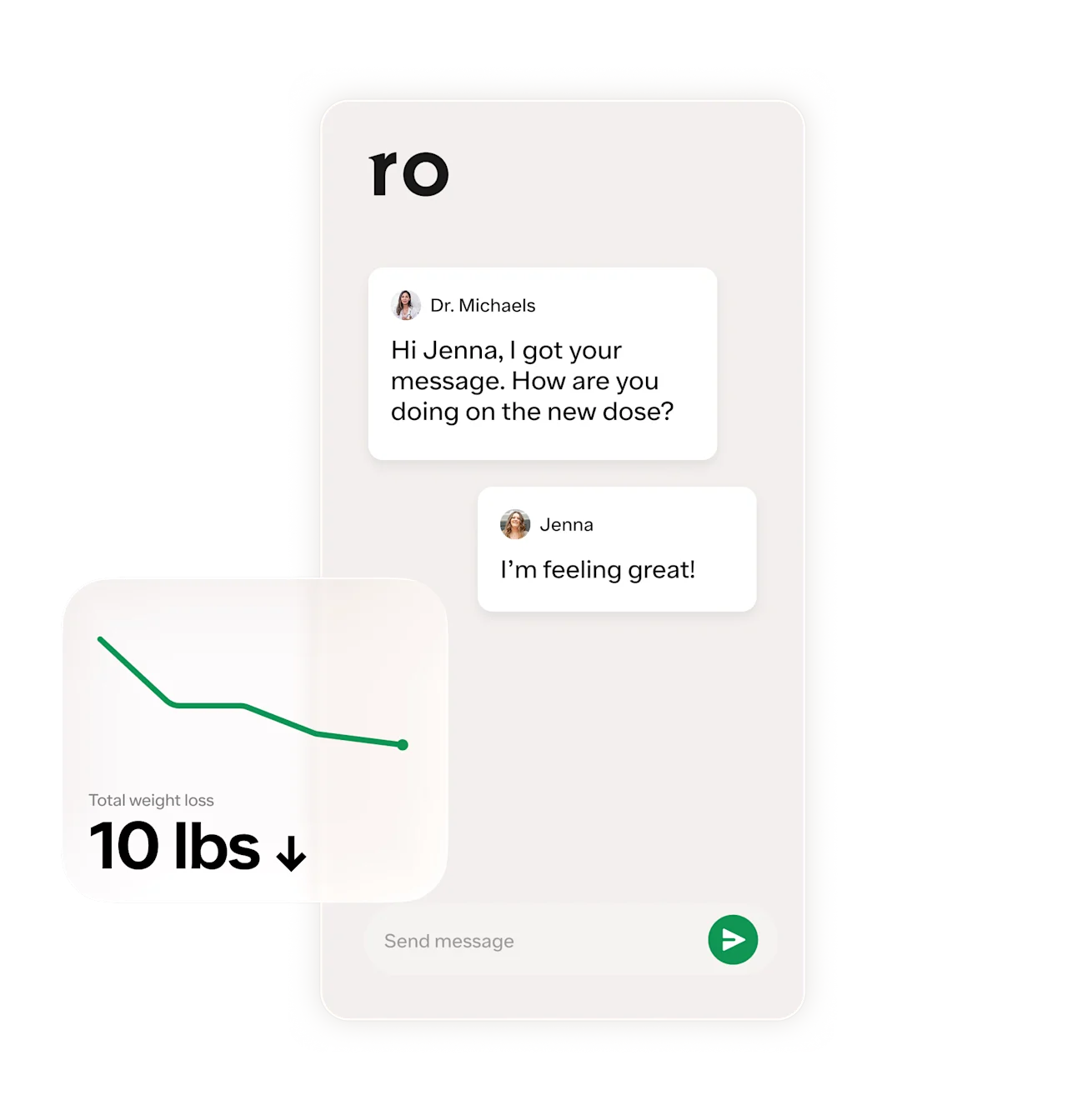Key takeaways
Tirzepatide can be a powerful tool for people embarking on a weight loss journey. In clinical trials, the drug causes an average weight reduction of up to 20.9% in a year and a half.
Tirzepatide slows down digestion, reduces food noise, and acts on brain receptors that regulate your appetite, all of which make it highly effective at reducing body weight.
Tirzepatide mimics two gut hormones naturally produced in your body, which makes it more effective at both weight loss and blood sugar control than other GLP-1 medications that mimic a single hormone.
Here's what we'll cover
Here's what we'll cover
Here's what we'll cover
Key takeaways
Tirzepatide can be a powerful tool for people embarking on a weight loss journey. In clinical trials, the drug causes an average weight reduction of up to 20.9% in a year and a half.
Tirzepatide slows down digestion, reduces food noise, and acts on brain receptors that regulate your appetite, all of which make it highly effective at reducing body weight.
Tirzepatide mimics two gut hormones naturally produced in your body, which makes it more effective at both weight loss and blood sugar control than other GLP-1 medications that mimic a single hormone.
Tirzepatide is the active ingredient in the brand-name prescription medications Mounjaro and Zepbound. In clinical trials of people with obesity, tirzepatide led to an average weight loss of up to 20.9% in about a year and a half. The drug’s weight loss results are undeniable, but the question remains: how does tirzepatide work? More specifically, how does tirzepatide work for weight loss, and does tirzepatide burn fat?
Read on as we answer these questions and more.
What is tirzepatide?
Tirzepatide is the active ingredient in Mounjaro and Zepbound. Both medications are once-weekly injections that cause weight loss. They share the same active ingredient and mechanism of action and come in the same dosage amounts. The key difference between Zepbound and Mounjaro is their approved indications.
The US Food & Drug Administration (FDA) first approved Mounjaro in 2022 as a treatment for type 2 diabetes. As researchers became aware of the drug’s potent weight loss effects, Eli Lilly sought approval for a new indication. In 2023, the FDA approved Zepbound for weight loss and chronic weight management in people with obesity or overweight and a weight-related health condition (e.g., high blood pressure, sleep apnea). In December 2024, the FDA further expanded tirzepatide’s indications, approving Zepbound for the treatment of moderate to severe obstructive sleep apnea (OSA) in adults with obesity.
Both medications are meant to be used in combination with lifestyle changes like diet and exercise.
How does tirzepatide work?
“Tirzepatide is an agonist of two molecules working together: glucagon-like peptide-1 (GLP-1) and the novel molecule glucose-dependent insulinotropic polypeptide (GIP),” says Peminda K. Cabandugama, MD, a Clinical Associate Professor of Medicine at the Cleveland Clinic who is board-certified in obesity and endocrinology.
This combination of both GLP-1 and GIP in one medication creates a complimentary effect that is thought to make tirzepatide more effective for both weight loss and type 2 diabetes than a similar medication, semaglutide, which is the active ingredient in Ozempic and Wegovy.
GIP and GLP-1 are natural hormones that play key roles in regulating your blood sugar and appetite. After you eat, these hormones prompt the pancreas to stimulate insulin release and signal the liver to reduce glucose production, helping to maintain stable blood sugar levels. Additionally, they slow the rate at which food moves from the stomach to the small intestine—a process called gastric emptying—and communicate with the brain to create a sense of fullness. Emerging research suggests these hormones may also help curb cravings and reduce "food noise," the constant preoccupation with food and intrusive thoughts about eating.
“When you have a meal, tirzepatide stimulates the pancreas to release insulin. This helps to lower your blood sugar when you have a meal. It also prevents the medication from causing low blood sugar because it’s food that stimulates the medication to work to release insulin,” Dr. Cabandugama says. “If you ask any endocrinologist, we didn’t think that we would have in our lifetime a diabetic medication that doesn’t give you low blood sugar [as a side effect]. So, it’s a game changer for both weight loss and type 2 diabetes.”
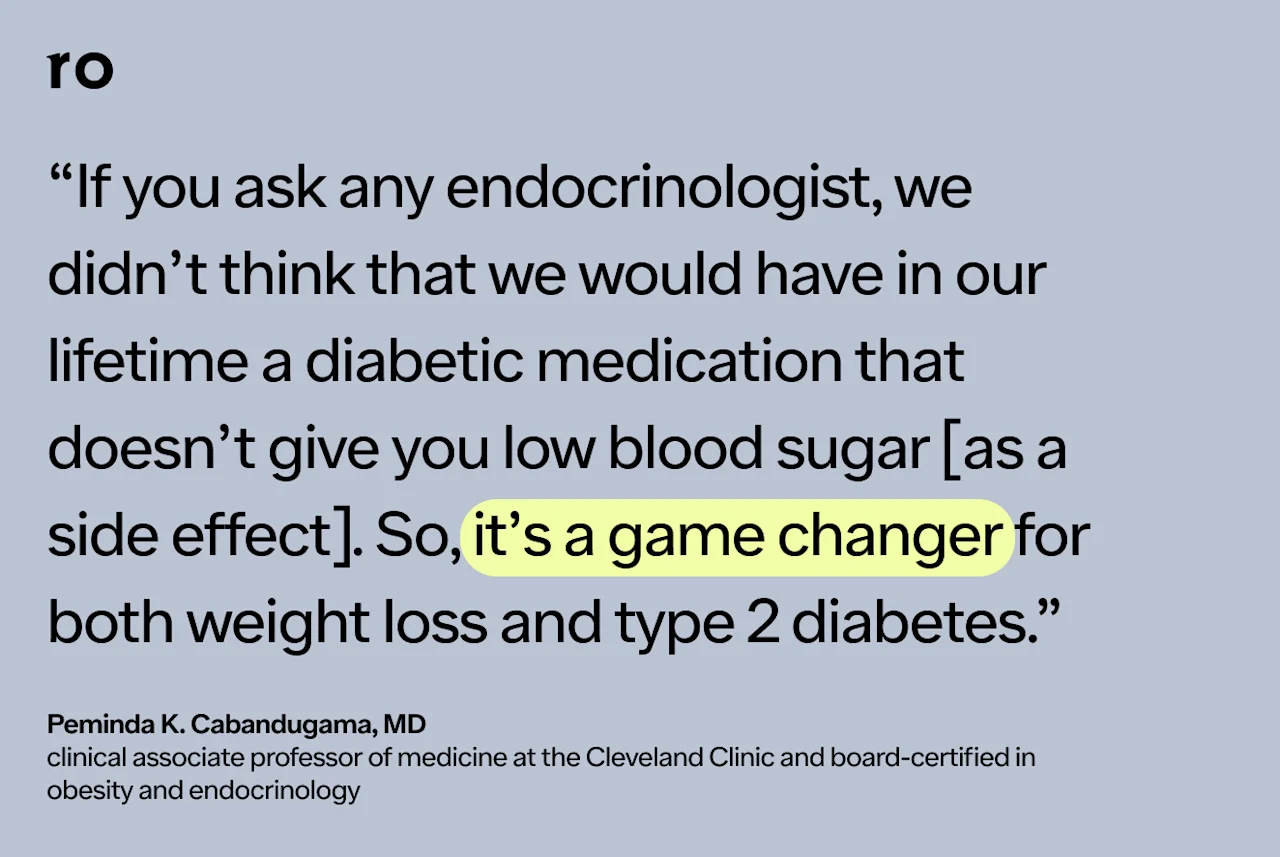
How does tirzepatide work for weight loss?
“For weight loss, tirzepatide slows gastric emptying, which slows down the passage of food in your stomach,” says Dr. Cabandugama. “If food is in your stomach longer, you'll be full longer and less hungry. Patients tell me that it also calms down food noise. Researchers think it affects the hypothalamus where our cravings come from.”
Tirzepatide can cause significant weight loss, according to clinical studies. People with obesity or overweight lost between 15–20.9% of their body weight in 72 weeks (about a year and a half), with those taking higher doses of Zepbound losing more weight.
An analysis of ten studies found that people taking tirzepatide lost more weight, on average, than those taking other weight loss or diabetes medications. They lost 21.6 more pounds than those taking a placebo, 4.3 more pounds than those taking insulin, and 2.3 more pounds than those taking other GLP-1 medications. The studies ranged in duration from 12 to 72 weeks, and the participants in all but one of the studies had type 2 diabetes.
Among people with type 2 diabetes, tirzepatide led to an average weight loss of 12.8–14.7% on the two highest doses of Mounjaro. In another study comparing Mounjaro vs. Ozempic, those taking tirzepatide lost 9.7% more body fat in seven months. Those taking Ozempic, on the other hand, lost just under 6%.
How long does it take for tirzepatide to work?
Tirzepatide starts working as soon as you take it, but it takes about four weeks before it reaches a steady concentration in your bloodstream. It’s around this point that people usually start to notice weight loss.
While a 4% weight loss is a strong start, it's generally not quite enough to be seen as clinically significant in terms of overall health benefits for people with type 2 diabetes. Weight loss of at least 5% is the benchmark for meaningful weight loss, according to the American Diabetes Association.
From a diabetes management perspective, clinical trials of Mounjaro also showed that it can take up to three months to see meaningful improvements in HbA1c levels. By this time, average HbA1c levels dropped to prediabetes levels (6.4%) or lower. At the end of this 40-week study, HbA1c levels had dropped by 2.0–2.3%, and the average body weight reduction was 7.6–11.2%.
Does tirzepatide get rid of belly fat?
Belly fat, or the fat stored in the abdomen, is often where many people on a weight loss journey want to see the most improvement. But can tirzepatide actually help you get rid of belly fat?
“I get asked this by patients all the time,” says Dr. Cabandugama. “They’ll ask me, ‘Can you reduce the size of my belly (or breasts or thighs)?’ I tell them that is plastic surgery. Tirzepatide will help you lose weight, but weight can come from all different places.”
In short, yes tirzepatide can make you lose belly fat (participants in one clinical trial lost on average 7 inches from their waist), but it can also make you lose fat from all over your body. While it’s not possible to target your fat loss to a specific area (without plastic surgery) it’s likely that someone on tirzepatide will lose fat from their belly while reducing their overall body fat.
How to take tirzepatide
How you take tirzepatide depends on whether your medication comes in a prefilled pen or in a vial.
How to inject a tirzepatide pen
Here’s how to inject a tirzepatide pen, using the instructions from Eli Lilly, the maker of Zepbound and Mounjaro.
Wash your hands thoroughly with soap and water.
Inspect the pen. Confirm that you have the right dose and that the medication has not expired. The medicine should be clear and colorless (or slightly yellow). If it is frozen, cloudy, or contains particles, dispose of the pen and use a new one.
Choose your injection site. It can be the back of your upper arm if someone is helping you, or if you’re self-injecting, you can choose the front or outer side of your thigh, or anywhere on your abdomen at least two inches away from your belly button. Rotate injection sites, choosing a spot that’s at least one finger’s width away from where you last injected tirzepatide. Avoid areas with scars, rashes, or bruises.
Remove the gray base cap from the pen and throw it away.
Place the clear base of the pen flat against the skin at your injection site.
Unlock the pen by twisting it where you see the “lock” symbol.
Press down on the purple injection button and hold for 5–10 seconds. You’ll hear two clicks: the first indicates that the injection has started, and the second indicates that it is complete. The gray plunger will also be fully visible when the injection is complete.
After the injection, dispose of the pen in a FDA-cleared sharps disposal container. Don’t worry if you see a drop of liquid or blood on your skin; just apply gentle pressure with a cotton ball or alcohol swab. Don’t rub the area.
How to inject tirzepatide from a vial
To inject tirzepatide from a vial, follow these steps.
Wash your hands thoroughly with soap and water.
Remove the vial from the refrigerator and gather your sterile syringe with a needle and two alcohol wipes.
Inspect the vial. Confirm that you have the right dose and that the medication has not expired. The medicine should be clear and colorless (or slightly yellow). If it is frozen, cloudy, or contains particles, do not use it.
Shake and clean the vial. Pull off the plastic cap, but keep the rubber stopper in place. Clean the top of the rubber stopper with one of your alcohol wipes.
Remove the caps from the plunger and the needle. Do not touch the needle while you do this, so things stay sterile.
Hold the syringe with the needle pointing up. Pull down the plunger to fill the needle with air up to the 0.5 mL line.
Place the vial on a flat surface and insert the needle into the vial. Push down to inject all of the air into the vial.
With the needle still inside the vial, turn the vial upside down. The needle tip should be surrounded by liquid.
Pull the plunger just past the 0.5 mL line.
Flick the syringe with your finger to remove any air bubbles.
Push the plunger back up to the 0.5 mL line.
Remove the syringe from the vial and apply a new seal sticker to the cap of the vial.
Choose your injection site. It can be the back of your upper arm (if someone’s helping you), the front or outer side of your thigh, or anywhere on your abdomen at least two inches away from your belly button. Choose a spot that’s at least one finger’s width away from where you last injected tirzepatide. Avoid areas with scars, rashes, or bruises.
Wipe your skin with your second alcohol wipe. Let it dry.
Hold the syringe with the needle facing up, and push down on the plunger just enough for a drop of liquid to form at the end of the needle.
Pinch the skin at your injection site and quickly push the needle into it, making sure to insert the full length of the needle. Slowly push down on the plunger to inject your full dose.
Pull out the needle and discard the syringe in a FDA-cleared sharps disposal container. If you bleed, gently press on the area with a cotton ball or an alcohol swab—don’t rub it.
How to maximize weight loss on tirzepatide
When it comes to maximizing weight loss on tirzepatide, it’s all about implementing diet and exercise changes and finding the right healthcare team. They can help you determine the right dosage and guide you toward the best results.
1. Find the right dosage of tirzepatide for you
It’s important to make sure you find the right dose for your body, Dr. Cabandugama says. While there is a standard dosage schedule, not everyone will benefit from the same titration. A modified dose-escalation schedule, while considered off-label since it is not the same as the manufacturer’s instructions, may be recommended by your medical team depending on your goals and side effects.
“The FDA did approve these medications’ doses to be increased every four weeks but you’ll see most of the folks who experience weight loss will not increase every four weeks unless they have to,” he says. “It’s not a race to get to the top dose; it’s about maximizing each dose of the medication. See a healthcare provider who will follow you closely to make sure you're doing well.”
2. Improve your diet and exercise routine
Tirzepatide works best when combined with lifestyle changes like a healthy diet and exercise. Certain foods can worsen tirzepatide’s side effects and hinder your weight loss results, including heavy meals and fatty, fried, or ultra-processed foods.
“See a dietitian or nutritionist to make sure you're maximizing your diet and getting enough protein intake, which is a building block for hair and nails,” says Dr. Cabandugama. “We’re not trying to stop you from eating; it’s about helping you go back to healthier choices when eating, and experiencing less cravings.”
To lose weight, it is important to eat less, but maintaining that weight loss requires regular exercise. According to Dr. Cabandugama, research consistently supports the importance of physical activity in sustaining long-term results, with guidelines recommending at least 150 minutes of exercise per week. Try to find a routine that works for you whether it’s 1.5 hours a day on the weekend or 30 minutes a day throughout the week
3. Expand your healthcare team
Having a comprehensive approach to weight loss can maximize your results on tirzepatide. In addition to your prescribing doctor, you may want to meet with other healthcare providers as well, such as a dietitian and, if needed, a plastic surgeon.
“When patients lose a bunch of weight, they start to get loose or excess skin which has its own weight, so having a multidisciplinary approach where you can get rid of that excess skin is also helpful,” says Dr. Cabandugama.
How to get tirzepatide
Tirzepatide is a prescription medication, so you’ll need to see a healthcare provider in order to get it. Here are the steps you can take to get tirzepatide for weight loss or type 2 diabetes either online or in-person.
Step 1: Consult a healthcare provider
The first step in getting tirzepatide is making an appointment with a licensed healthcare provider who can write prescriptions. You can meet with your primary care physician (PCP), or an endocrinologist or weight loss specialist.
If you prefer, you can also connect with a healthcare provider online through a direct-to-patient healthcare company such as Ro. Direct-to-patient companies offer a convenient way to access medications like tirzepatide, particularly for those who prefer virtual consultations or want to get their medication faster.
During your appointment, your healthcare provider will determine if tirzepatide is the right treatment option for you. Come prepared to share your medical history, current medications and health conditions, and goals for weight loss or type 2 diabetes. (With a company such as Ro, you may answer these questions before your visit via an online questionnaire.)
This information helps your provider assess whether tirzepatide will be a safe and effective option for you. They may also order lab tests before recommending tirzepatide or another treatment.
If you and your healthcare provider decide you are a good fit for tirzepatide, they’ll write you a prescription.
Step 2: Verify your insurance coverage
It can be helpful to confirm whether your insurance plan covers tirzepatide before you head to the pharmacy. Some direct-to-patient healthcare companies, including Ro, will connect with your insurance plan on your behalf to determine coverage.
Not all insurance plans cover tirzepatide. When they do, prior authorization is typically required. This means your healthcare provider will need to submit paperwork to your insurance plan showing that you are a) taking tirzepatide for an FDA-approved condition (e.g. type 2 diabetes for Mounjaro and weight loss or management or sleep apnea for Zepbound) and b) you meet certain criteria. These criteria can depend on the insurer and which brand name version of tirzepatide you are taking:
For Mounjaro, you will need a diagnosis of type 2 diabetes.
For Zepbound, you will need to have obesity or overweight with a weight-related health condition such as high blood pressure, high cholesterol, or type 2 diabetes. Or you will need to have obesity and moderate to severe obstructive sleep apnea.
If your insurance doesn’t cover tirzepatide, there are still ways you can save on the cost of tirzepatide. Eli Lilly offers Savings Cards for both Mounjaro and Zepbound that can bring the cost down significantly for eligible individuals. There are also several websites, such as GoodRx, Optum Perks, or SingleCare, that share pharmacy-specific coupons for Zepbound and Mounjaro.
Step 3: Fill your prescription
When you’re ready to fill your prescription, you can either bring it to your preferred pharmacy or have your doctor send it electronically.
If you received your prescription through a company like Ro, they’ll handle the process of filling it for you. Many direct-to-patient healthcare companies will ship tirzepatide directly to your home, and some local pharmacies offer home shipping as well.
Questions to ask your doctor about tirzepatide for weight loss
Here are some questions you may want to ask your healthcare provider when you meet with them to discuss taking tirzepatide for weight loss.
Is tirzepatide a good option for me based on my medical history, current health conditions, and weight loss goals?
What kind of results should I realistically expect when taking tirzepatide for weight loss?
How does tirzepatide compare to other weight loss medications?
What is the appropriate starting dose for me, and how will my dose be adjusted over time?
How long should I expect to take tirzepatide?
What are the potential side effects of tirzepatide, and how common are they? How do I know when a side effect is normal vs. potentially serious?
Are there any long-term risks associated with using tirzepatide for weight loss?
Will tirzepatide interact with any other prescription or over-the-counter medicines I’m currently taking?
Do I need to follow a specific diet or exercise plan while taking tirzepatide?
How will my progress be monitored while I’m on tirzepatide?
What signs or symptoms should I look for that might indicate a problem or the need to adjust my treatment?
Is tirzepatide covered by my insurance plan, and what are the out-of-pocket costs?
Are there patient assistance programs or discounts available for tirzepatide?
If tirzepatide doesn’t work for me, what other options do you recommend?
Rx weight loss with Ro
Get access to prescription weight loss medication online
Bottom line
Tirzepatide (the active ingredient in Mounjaro and Zepbound) is a dual GLP-1 and GIP receptor agonist. This combination enhances insulin release, reduces glucose production, slows gastric emptying, and suppresses appetite, making it more effective for weight loss and type 2 diabetes compared to single GLP-1 receptor agonists like Ozempic and Wegovy.
As for how tirzepatide works for weight loss, the drug slows gastric emptying, prolonging feelings of fullness, and affects appetite-regulating areas in the brain, leading to reduced cravings and "food noise" (constant preoccupation with food).
Clinical trials showed that tirzepatide can produce an average weight loss of 15–20.9% over 72 weeks. It also demonstrates superior fat loss compared to other GLP-1 medications.
Tirzepatide is available in prefilled pens or vials. To take tirzepatide, you give yourself a subcutaneous injection once a week. It starts working immediately, but significant weight loss and improved blood sugar control typically become noticeable within the first few months of use.
Tirzepatide has some downsides, including a long list of side effects and a high out-of-pocket cost. Many of tirzepatide’s most common side effects like nausea, diarrhea, and abdominal pain typically subside over time. Rare but serious side effects include pancreatitis, gallbladder issues, and kidney problems. It is also expensive, and insurance coverage may vary depending on whether it’s prescribed for type 2 diabetes or weight loss.
Frequently asked questions (FAQs)
What are the drawbacks of tirzepatide?
Tirzepatide is an effective medication, but like most prescription medications, it has some downsides to consider. First, it has a long list of side effects, which range from nausea and diarrhea to gassiness and hair loss. Most of the drug’s digestive side effects lessen with time, but they can be intense enough to cause a small number of people to stop taking tirzepatide. And while rare, serious side effects can also occur, including pancreatitis, and kidney or gallbladder problems that may or may not be related to the medication.
Tirzepatide can also be expensive, with an out-of-pocket cost upwards of $1,000. Insurance coverage also varies, especially when taken for weight loss. For example, Medicare does not cover weight loss drugs at all, and Medicaid coverage can vary by state.
Finally, tirzepatide is meant to be a long-term medication for type 2 diabetes or weight management. This is another potential drawback for some people, especially when you factor in tirzepatide’s side effects and high cost.
It may not necessarily be a lifelong treatment for everyone, so talk to your healthcare provider. There may be ways they can adjust your treatment, says Dr. Cabandugama. “When I talk to a patient, they give me a goal they want to get to and I check that it’s safe. If they have type 2 diabetes or cardiovascular disease, I give them the option to taper off once they meet that goal.”
What are tirzepatide side effects?
The most common side effects of tirzepatide include:
Nausea
Diarrhea
Vomiting
Constipation
Abdominal pain
Dyspepsia (upset stomach or indigestion)
Injection site reactions (e.g. bruising, pain, itching)
Fatigue
Eructation (belching)
Gastroesophageal reflux disease (GERD) or heartburn
Flatulence
Abdominal distension (bloating)
Dizziness
Hypotension (low blood pressure)
Thankfully, most of tirzepatide’s digestive side effects go away with time as your body gets used to the medication.
In rare cases, tirzepatide can cause more serious side effects, including pancreatitis, kidney or gallbladder problems, suicidal behavior or ideation, severe allergic reactions, pulmonary aspiration during general anesthesia, and hypoglycemia or diabetic retinopathy complications in people with type 2 diabetes.
Can I drink coffee on tirzepatide?
While you can drink coffee on tirzepatide, you may be more likely to experience gastrointestinal side effects if you do so. Caffeine can worsen some of the GI symptoms associated with tirzepatide, including diarrhea and heartburn. Coffee can also contribute to dehydration, which is already more common with tirzepatide thanks to fluid-depleting side effects like vomiting, nausea, and diarrhea. If you’re not regularly replenishing your fluids, the dehydration can become so severe that it increases the likelihood of experiencing serious side effects on tirzepatide, including kidney failure.
To prevent serious side effects, make sure to drink plenty of water and other non-caloric fluids slowly and frequently throughout the day. It also helps to learn the signs of dehydration, which induce decreased urine output, dizziness, and dry mouth.
DISCLAIMER
If you have any medical questions or concerns, please talk to your healthcare provider. The articles on Health Guide are underpinned by peer-reviewed research and information drawn from medical societies and governmental agencies. However, they are not a substitute for professional medical advice, diagnosis, or treatment.
Mounjaro Important Safety Information: Read more about serious warnings and safety info.
Zepbound Important Safety Information: Read more about serious warnings and safety info.
Wegovy Important Safety Information: Read more about serious warnings and safety info.
Ozempic Important Safety Information: Read more about serious warnings and safety info.
References
Aronne, L. J., Sattar, N., Horn, D. B., et al. (2024). Continued Treatment With Tirzepatide for Maintenance of Weight Reduction in Adults With Obesity: The SURMOUNT-4 Randomized Clinical Trial. JAMA, 331(1), 38–48. doi: 10.1001/jama.2023.24945. Retrieved from https://pmc.ncbi.nlm.nih.gov/articles/PMC10714284/
Balfour, J. & Boster, J. (2023). Physical Activity and Weight Loss Maintenance. StatPearls. Retrieved from https://www.ncbi.nlm.nih.gov/books/NBK572051/
Cai, W., Zhang, R., Yao, Y., et al. (2024). Tirzepatide as a novel effective and safe strategy for treating obesity: a systematic review and meta-analysis of randomized controlled trials. Frontiers in Public Health, 12, 1277113. doi: 10.3389/fpubh.2024.1277113. Retrieved from https://pmc.ncbi.nlm.nih.gov/articles/PMC10864442/
Eli Lilly-a. (2024). How much should I expect to pay for Mounjaro (tirzepatide)?. Retrieved from https://pricinginfo.lilly.com/mounjaro
Eli Lilly-b. (2024). Mounjaro Instructions for Use. Retrieved from https://uspl.lilly.com/mounjaro/mounjaro.html#ug
Eli Lilly-c. (2023). Zepbound Instructions for Use. Retrieved from https://uspl.lilly.com/zepbound/zepbound.html#ug
Farzam, K. & Patel, P. (2024). Tirzepatide. StatPearls. Retrieved from https://www.ncbi.nlm.nih.gov/books/NBK585056/
Garvey, W. T., Frias, J. P., Jastreboff, A. M., et al. (2023). Tirzepatide once weekly for the treatment of obesity in people with type 2 diabetes (SURMOUNT-2): a double-blind, randomised, multicentre, placebo-controlled, phase 3 trial. Lancet (London, England), 402(10402), 613–626. doi: 10.1016/S0140-6736(23)01200-X. Retrieved from https://pubmed.ncbi.nlm.nih.gov/37385275/
Gorgojo-Martínez, J. J., Mezquita-Raya, P., Carretero-Gómez, J., et al. (2022). Clinical Recommendations to Manage Gastrointestinal Adverse Events in Patients Treated with Glp-1 Receptor Agonists: A Multidisciplinary Expert Consensus. Journal of Clinical Medicine, 12(1), 145. doi: 10.3390/jcm12010145. Retrieved from https://pmc.ncbi.nlm.nih.gov/articles/PMC9821052/
Hayashi, D., Edwards, C., Emond, J. A., et al. (2023). What Is Food Noise? A Conceptual Model of Food Cue Reactivity. Nutrients, 15(22), 4809. doi: 10.3390/nu15224809. Retrieved from https://pmc.ncbi.nlm.nih.gov/articles/PMC10674813/
Heise, T., DeVries, J. H., Urva, S., et al. (2023). Tirzepatide Reduces Appetite, Energy Intake, and Fat Mass in People With Type 2 Diabetes. Diabetes Care, 46(5), 998–1004. doi: 10.2337/dc22-1710. Retrieved from https://pmc.ncbi.nlm.nih.gov/articles/PMC10154650/
Jastreboff, A. M., Aronne, L. J., Ahmad, N. N., et al. (2022). Tirzepatide Once Weekly for the Treatment of Obesity. The New England Journal of Medicine, 387(3), 205–216. doi: 10.1056/NEJMoa2206038. Retrieved from https://www.nejm.org/doi/10.1056/NEJMoa2206038
Lee, S. & Lee, D. Y. (2017). Glucagon-like peptide-1 and glucagon-like peptide-1 receptor agonists in the treatment of type 2 diabetes. Annals of Pediatric Endocrinology & Metabolism, 22(1), 15–26. doi: 10.6065/apem.2017.22.1.15. Retrieved from https://pmc.ncbi.nlm.nih.gov/articles/PMC5401818/
Lin, F., Yu, B., Ling, B., et al. (2023). Weight loss efficiency and safety of tirzepatide: A Systematic review. PloS One, 18(5), e0285197. doi: 10.1371/journal.pone.0285197. Retrieved from https://pmc.ncbi.nlm.nih.gov/articles/PMC10159347/
Maselli, D. B., & Camilleri, M. (2021). Effects of GLP-1 and Its Analogs on Gastric Physiology in Diabetes Mellitus and Obesity. Advances in Experimental Medicine and Biology, 1307, 171–192. doi: 10.1007/5584_2020_496. Retrieved from https://pubmed.ncbi.nlm.nih.gov/32077010/
Rodriguez, P. J., Goodwin Cartwright, B. M., Gratzl, S., et al. (2024). Semaglutide vs Tirzepatide for Weight Loss in Adults With Overweight or Obesity. JAMA Internal Medicine, 184(9), 1056–1064. doi: 10.1001/jamainternmed.2024.2525. Retrieved from https://pmc.ncbi.nlm.nih.gov/articles/PMC11231910/
Samms, R. J., Coghlan, M. P., & Sloop, K. W. (2020). How May GIP Enhance the Therapeutic Efficacy of GLP-1?. Trends in Endocrinology and Metabolism: TEM, 31(6), 410–421. doi: 10.1016/j.tem.2020.02.006. Retrieved from https://www.cell.com/trends/endocrinology-metabolism/fulltext/S1043-2760(20)30048-5
U.S. Food & Drug Administration (FDA). (2023). FDA Approves New Medication for Chronic Weight Management. Retrieved from https://www.fda.gov/news-events/press-announcements/fda-approves-new-medication-chronic-weight-management
U.S. Food & Drug Administration (FDA-a). (2024). FDA Approves First Medication for Obstructive Sleep Apnea. Retrieved from https://www.fda.gov/news-events/press-announcements/fda-approves-first-medication-obstructive-sleep-apnea
U.S. Food & Drug Administration (FDA-b). (2024). Prescribing Information: Mounjaro (tirzepatide injection, for subcutaneous use. Retrieved from https://www.accessdata.fda.gov/drugsatfda_docs/label/2024/215866s010s015s022lbl.pdf
U.S. Food & Drug Administration (FDA-c). (2024). Prescribing Information: Zepbound (tirzepatide injection, for subcutaneous use. Retrieved from https://www.accessdata.fda.gov/drugsatfda_docs/label/2024/217806s005s006s011s015s019lbl.pdf
U.S. Food & Drug Administration (FDA-d). (2024). Prescribing Information: Zepbound (tirzepatide injection, for subcutaneous use). Retrieved from https://www.accessdata.fda.gov/drugsatfda_docs/label/2024/217806s013lbl.pdf
Wadden-a, T. A., Chao, A. M., Moore, M., et al. (2023). The Role of Lifestyle Modification with Second-Generation Anti-obesity Medications: Comparisons, Questions, and Clinical Opportunities. Current Obesity Reports, 12(4), 453–473. doi: 10.1007/s13679-023-00534-z. Retrieved from https://pmc.ncbi.nlm.nih.gov/articles/PMC10748770/
Wadden-b, T. A., Chao, A. M., Machineni, S., et al. (2023). Tirzepatide after intensive lifestyle intervention in adults with overweight or obesity: the SURMOUNT-3 phase 3 trial. Nature Medicine, 29(11), 2909–2918. doi: 10.1038/s41591-023-02597-w. Retrieved from https://pmc.ncbi.nlm.nih.gov/articles/PMC10667099/
Young, G. M., Bansal, K., Riello, R. J., 3rd, et al. (2024). Medicare Coverage and Patient Out-of-Pocket Costs for Cardiovascular-Kidney-Metabolic Medications. JAMA Network Open, 7(5), e2412437. doi: 10.1001/jamanetworkopen.2024.12437. Retrieved from https://pmc.ncbi.nlm.nih.gov/articles/PMC11109768/
Zepbound.com. (2024). Your weekly Zepbound routine. Eli Lilly. Retrieved from https://zepbound.lilly.com/how-to-use


